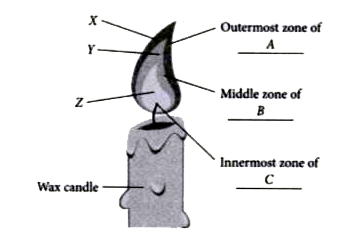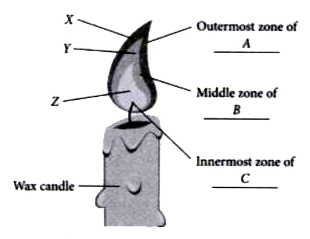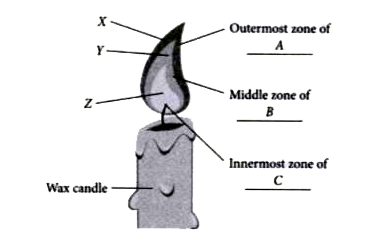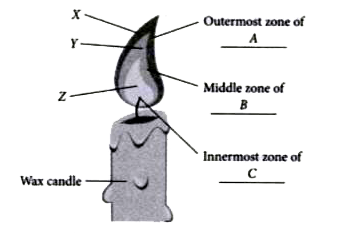The substances which vapourise during ________ give flame.
Step-by-Step Text Solution:
1. Understanding the Question: The question is asking about substances that vaporize and produce a flame when they are burned.
2. Identifying Key Terms: The key term here is "vaporize," which refers to the process of a substance changing from a liquid or solid state into a gas. The question also mentions "give flame," indicating that we are looking for substances that produce a visible flame when they burn.
3. Defining Inflammable Substances: Inflammable substances are those that ignite easily and burn with a flame. These substances vaporize during combustion, which is the process of burning.
4. Examples of Inflammable Substances: Common examples of inflammable substances include kerosene, gasoline, and alcohol. These substances vaporize when heated and produce a flame.
5. Distinguishing Between Burning and Non-Flame Producing Substances: Not all substances that burn produce a flame. For instance, coal burns but does not produce a visible flame due to the high temperature of combustion.
6. Filling in the Blank: Based on the understanding that substances that vaporize during burning give flame, we can conclude that the blank in the question should be filled with the word "burning."
Final Answer: The substances which vaporize during burning give flame.
---
Topper's Solved these Questions
- COMBUSTION AND FLAME BOOK - NCERT EXEMPLARCHAPTER - COMBUSTION AND FLAME EXERCISE - SHORT ANSWER QUESTIONS
12 Videos
- COMBUSTION AND FLAME BOOK - NCERT EXEMPLARCHAPTER - COMBUSTION AND FLAME EXERCISE - SHORT ANSWER QUESTIONS (Write True/False against the following statements and also correct the false statement.)
7 Videos
- COMBUSTION AND FLAME BOOK - NCERT EXEMPLARCHAPTER - COMBUSTION AND FLAME EXERCISE - LONG ANSWER QUESTIONS
7 Videos
- COAL AND PETROLEUMBOOK - NCERT EXEMPLARCHAPTER - COAL AND PETROLEUMEXERCISE - LONG ANSWER QUESTIONS
9 Videos
- CONSERVATION OF PLANTS AND ANIMALS BOOK - NCERT EXEMPLARCHAPTER - CONSERVATION OF PLANTS AND ANIMALS EXERCISE - LONG ANSWER QUESTIONS
3 Videos
Similar Questions
Knowledge Check
Which of the following statements are correct?
I. Yellow flames are ideal for heating.
II. The substances which vaporise during burning give flames.
III. Luminous zone contains unburnt carbon particles.
IV. The non-luminous zone has the highest temperature.AI, II and III onlyBII and IV onlyCII, III and IV onlyDI, III and IV onlyA flame is the visible gaseous part of a fire. It is a zone of combustion of gaseous substances accompanied by evolution of heat and light. All substances do not burn with a flame. Only those substances that vaporise during burning produce flame. A candle flame is taken to study the various zones of a flame.

Different zones of a candle flame are marked by the letters (A), (B) and (C).
Which of the following statements are correct?
(I) (B) is the hottest part of the flame.
(II) (C) is moderately hot.
(III) (A) is the hottest part of the flame.
(IV) (A) is moderately hot whereas (C) is the coldest part.
(V) (C) is the luminous zone.
(VI) (B) is the luminous zone.
(VII) (A) is the dark zone.A(III), (V) and (VII)B(III) and (VI)C(I), (IV) and (VI)DAll of theseA flame is the visible gaseous part of a fire. It is a zone of combustion of gaseous substances accompanied by evolution of heat and light. All substances do not burn with a flame. Only those substances that vaporise during burning produce flame. A candle flame is taken to study the various zones of a flame.

Which zone of a candle flame is the zone of no combustion?AOutermost zoneBMiddle zoneCInnermost zoneDNone of these
Fill in the following blanks with suitable words :
The substances which vaporise during burning, give ………………….
View SolutionThe substances which have very ____________ ignition temperature and can easily catch fire with a flame are called ________ substances.
View SolutionA flame is the visible gaseous part of a fire. It is a zone of combustion of gaseous substances accompanied by evolution of heat and light. All substances do not burn with a flame. Only those substances that vaporise during burning produce flame. A candle flame is taken to study the various zones of a flame.

The luminous and non-luminous zones of flame is respectively.
View SolutionA flame is the visible gaseous part of a fire. It is a zone of combustion of gaseous substances accompanied by evolution of heat and light. All substances do not burn with a flame. Only those substances that vaporise during burning produce flame. A candle flame is taken to study the various zones of a flame.

Arrange X, Y and Z in increasing order of temperature.
View SolutionA flame is the visible gaseous part of a fire. It is a zone of combustion of gaseous substances accompanied by evolution of heat and light. All substances do not burn with a flame. Only those substances that vaporise during burning produce flame. A candle flame is taken to study the various zones of a flame.

(A), (B) and (C) are respectively.
View Solution
